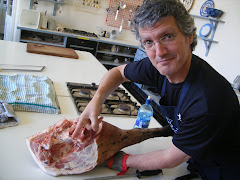Being American, I didn't grow up eating scones. My first exposure to scones was in England, put off by numerous examples of dry, tasteless and rock-heavy travesties. At Ballymaloe, making scones was part of our introduction to breads. It may have been that I was quite lucky but my first go at scones turned out fairly well. And to my surprise they weren't anything like the ones I had in England. Light, sweet and so full of flavor - you gotta love butter - they didn't even need jam or cream. These are sweeter than most, so you may prefer to scale back on the sugar as most people have them with jam. There aren't many things more comforting than a really lovely scone.
Makes 18
Ingredients
2 lb / 900 g plain flour
6 oz / 180 g unsalted butter; chilled, cut into 1/2 inch cubes
3 whole eggs
2 oz / 60 g caster sugar
3 heaped tsp baking powder
15 fl oz / 440 ml milk
egg wash
granulated sugar
Preheat oven to 250C / 480F. In as large a bowl you have, sieve all dry ingredients together. Add the butter and using a light hand, mix the butter and dry ingredients until it resembles course breadcrumbs. In a separate bowl, lightly whisk the eggs then adding the milk to mix well. Make a well in the center of the dry ingredients and add the egg/millk mixture, keeping back about 2 oz / 60 ml, bringing it to a soft dough. The dough should be of a consistency that it will just hold it's shape when cutting into rounds. Turn out onto the very lightly floured counter and gently roll out to about 1/2 inch thickness. Use a 2 or 3 inch round, dipping it into a small bowl of flour between cutting to keep it from tearing the dough. Bring any remaining dough together and roll once more to a thickness of 1/2 inch. The scones made at this point will be just a bit heavier, the more the dough is worked. So again, keep a light hand. Brush the tops with egg wash and dip into a plate of granulated sugar. Keep space between the scones on a baking tin and bake 10-15 minutes on the middle rack. A good indication of doneness is when the scones easily slide from the bottom of the tin. They're best eaten just a few minutes from the oven. Although they will keep in the fridge for ages if they taste of a cereal box.
Darina Allen
Things to remember
A key aspect of light and fluffy scones is coarse breadcrumbs...not fine as in some recipes. The coarser and larger bits of butter leave behind larger pockets of air as the butter melts into the scone, leaving you with a handful of heaven. Do experiment a bit and see what you prefer.
I tend to whisk eggs or egg whites on their own before adding any other ingredients as this breaks down the albumen (the stringy, gooey bit) in the whites.
It's best to keep back some liquid when initially adding to dry ingredients. As the weather changes, so does the amount of humidity and thus the amount of moisture in the flour. So there are times when you may need a bit more or a bit less of the liquid specified. As with all pastry and doughs, you'll develop a feel for the texture that you want. This is an aspect of baking where there is some wiggle-room.
Subscribe to:
Post Comments (Atom)




No comments:
Post a Comment